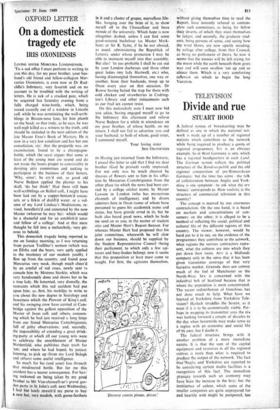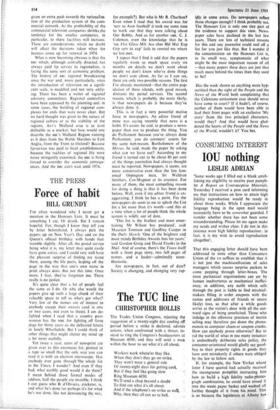Divide and rue
TELEVISION STUART HOOD
A-federal system of broadcasting may be defined as one in which the national net- work is made up of a number of regional stations which contribute to the network while being required to produce a quota of regional programmes. ITV is an obvious example. So in West Germany is ARD, which has a regional headquarters in each Land. The German system reflects the political structure of the Bundesrepublik and the old regional composition of pre-Bismarckean Germany; but the time has come—the talk of collaboration between Anglia and York- shire is one symptom—to ask what the my `mosaic' corresponds to. How realistic is the structure of commercial television in this country?
The concept is marred by one enormous contradiction. On the one. hand, it is based on markets and concentrations of con- sumers; on the other, it is alleged to be a method of reflecting the social, political and cultural life of the different regions of this country. The viewer, however, would be hard put to it to say, on the evidence of the programmes they contribute to the network, what regions the various contractors repre- sent, what the cultures are into which they put down their roots. ATV is a Midlands company only in the sense that it has been given transmitter coverage of that very lucrative market. Granada does not convey much of the feel of Manchester or the North-West. STV is concerned with the industrial belt of Scotland because that is where the population is most concentrated. The recent redistribution of franchises has not done much to help. What have we learned of Yorkshire from Yorkshire Tele- vision? Harlech straddles the Severn, as it must if it is to be economically viable. Per- haps in mapping its transmitter area the rra was looking forward a couple of decades to the day when Severnside may make sense as a region with an economic and social life of-itt own; but I doubt it.
The federal structure brings with it another problem of a more immediate nature. It is that the sum of the capital equipment and resources in all the regional centres is more than what is required to produce-the output of the network. The fact thal*Anglia and Yorkshire are reported to be considering certain studio facilities is a recognition of this fact. The immediate pressure towards such an economy may have been the increase in the levy; but the imminence of colour, which some of the smaller companies are quite unprepared for and heartily wish might be postponed, has
given an extra push towards the rationalisa- tion of the production system of the com- mercial network. As the profitability of the commercial television companies shrinks,the tendency for the smaller companies, in particular, to share facilities will increase. These are considerations which no doubt will affect the decisions taken when the licences come up for renewal in 1974.
What is now becoming obvious is that the sac which, although centrally directed, has always paid lip service to regionalism, is facing the same sort of economic problem. The history of sac regional broadcasting since the war and, more particularly, since the introduction of television on a signifi- cant scale, is muddled and not very edify- ing. There has been a welter of regional advisory committees. Regional controllers have been appeased by the planning and, in some cases, the building of regional com- plexes for ends that were never clear. But no hard thought was given to the nature of regional culture or to the viability of the regions. ATV'S Midland area is at least definable as a market; but how would one describe the BBC'S Midland Region running as it does from the Welsh Marches to East Anglia, from the Trent to Oxford? Because lip-service was paid to local establishments, because the realities of regional life were never stringently examined, the BBC is being forced to consider the economic consequ- ences. And the BBC can't wait until 1974.







































 Previous page
Previous page